Can you bake sourdough bread in a loaf pan? Absolutely! Using a sandwich loaf tin is a great option for baking sourdough bread. It creates uniform slices that are perfect for sandwiches. If you've just getting into sourdough baking and don't want to invest in special equipment like a Dutch oven, I'll show you how to make the loaf pan you already have work for bread baking!

Jump to:
Why I love using loaf pans for baking sourdough bread
Free form sourdough loaves are undeniably beautiful! But baking them usually requires special equipment like a banneton and a Dutch oven. If you don't want to invest in specialized tools just yet you can use baking equipment you already have in your kitchen to make bread.
In fact, baking sourdough bread in a loaf pan has a few unique advantages:
- Sandwich loaf pans provide structure, dough won’t spread and flatten out like free-form loaves. While you can bake any type of bread in a sandwich loaf pan, it's especially great for dough that tends to have a weaker structure like high-hydration bread, or bread that has a higher proportion of whole grain flour like like Sourdough Spelt Bread and Sourdough Discard Whole Wheat Sandwich Bread.
- Makes even slices of bread. Freeform loaves are beautiful but the slices rarely match up. Breads baked in a loaf pan have uniform slices perfect for sandwiches!
- Final proof, scoring, and baking are all done in one container, so there’s no need to fiddle with your dough after the second rise.
- Eliminates the need to invest in specialty tools, most home bakers already have a loaf pan, so there’s no need to purchase specialized bread equipment such as bannetons, Dutch ovens, or an expensive bread pan.
- Great for newbies! Using a sandwich tin is a great way to bake sourdough for new bakers who are not as comfortable with bread shaping since the loaf pan provides support and structure for the dough.

Looking for more sandwich bread recipes? Try my Sourdough Discard Whole Wheat Bread, Vegan Sourdough Discard Sandwich Bread and Sourdough Potato Bread.
Importance of steam in bread baking
Steam is a vital part of bread baking because it helps maximize oven spring.
Bread bakes at extremely high temperatures and without steam the crust hardens too quickly preventing the dough from expanding completely. Steam keeps the crust soft and elastic, without it bread bakes up compacted with a dense crumb and a very hard, thick crust. Steam allows the dough to rise fully and helps bread develop an open crumb, a beautiful rounded shape and a thin delicate crust.
How to create steam in a home oven
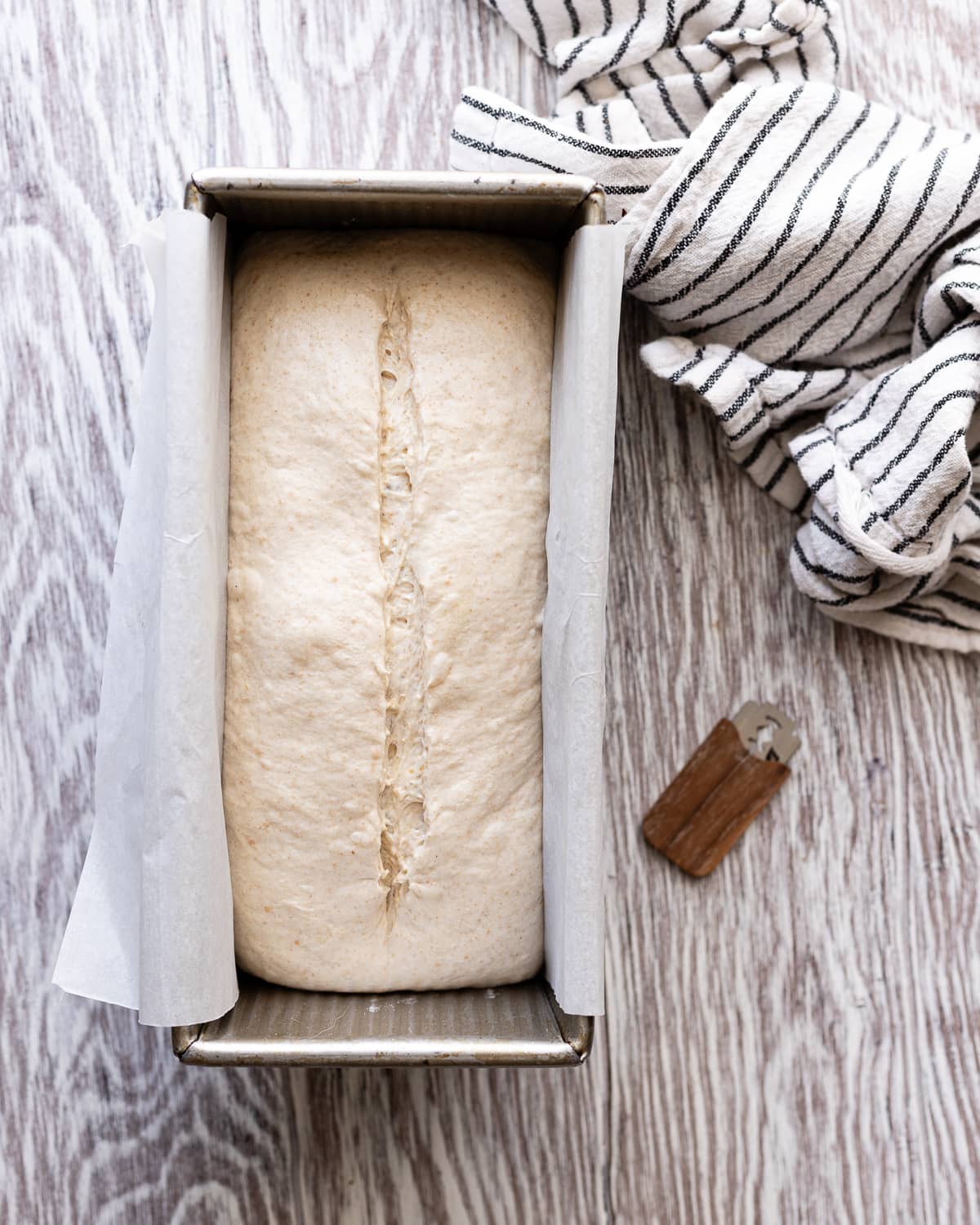
Bakeries and industrial kitchens are injected with steam, however, most conventional home ovens do not have this feature which requires bakers to exercise more creativity.
The easiest way to create steam while baking is to use a Dutch oven. As dough bakes, water in the dough evaporates creating water vapor. The heavy duty cast iron or enamel lid of a Dutch oven provides a seal that naturally traps water vapor in. This mimics the humid environment created by steam-injected ovens. However, you can still introduce steam in your oven and bake homemade sourdough bread even without a Dutch oven!
To create steam, all you need to do is add a water pan in your oven while your bread bakes. Ideally a metal baking pan or loaf pan filled with water. This will recreate a moist environment of a commercial steam-injected oven that's ideal for bread baking. You can even add ice cubes into the water pan which will generate extra steam in your oven.
All about oven spring
The rapid rise that bread undergoes during the first moments of baking is known as oven spring. Maximizing oven spring is crucial for a light and airy crumb.
What you need
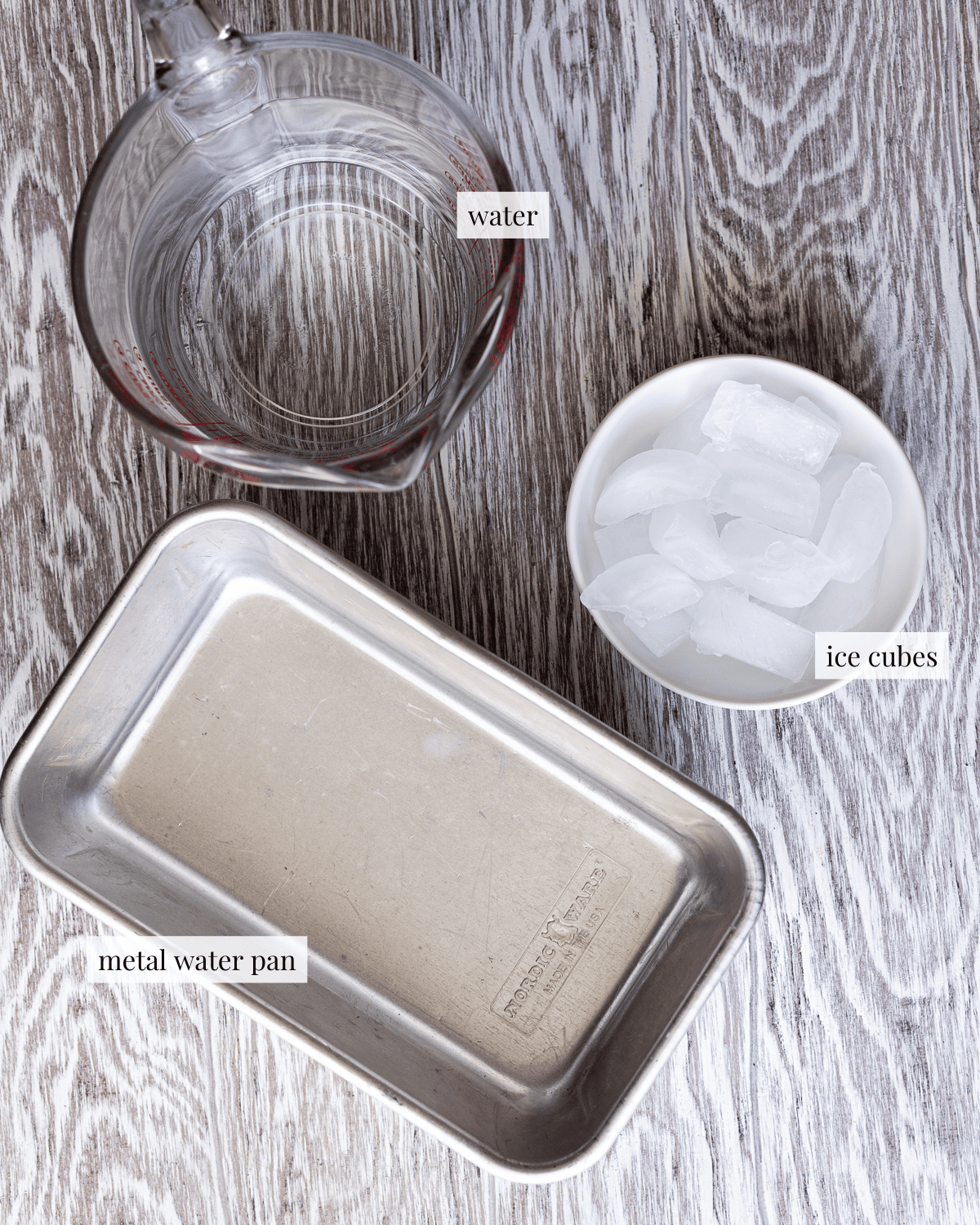
- A reliable sourdough bread recipe: You can bake any sourdough bread in a loaf pan (try my basic sourdough recipe)
- Pullman pan or loaf pan: The size of the pan you use will depend on the recipe you create. Either a 9 by 4 inch Pullman pan or 8 by 5 inch Loaf pan will work for most standard sourdough bread recipes.
- Water pan: A metal pan works best, avoid using ceramic, glass or clay since adding water or ice cubes to the pan could cause them to break due to thermal shock.
- Ice cubes: Adding ice cubes to hot water increases the amount of steam released by your water pan! If you don't have an ice maker - you can totally them.
- Baking stone or pizza stone (optional): Creates a super heated surface that replicates the radiant heat emitted by the floor of professional ovens. When the loaf pan makes contact with the stone, the intense heat prompts the dough to rise rapidly, resulting in a lighter crumb and taller loaf.
How to shape a sandwich loaf
Shaping is extremely important for the look and structure of freeform loaves. You’ll need to create enough surface tension so that your loaf can maintain its form and not collapse as it bakes.
Since a loaf pan provides support both during proofing and baking, your shaping technique becomes less important. The loaf pan also causes the loaf to rise higher. So if you get your proofing right, you’ll have a taller loaf that won’t flatten out.
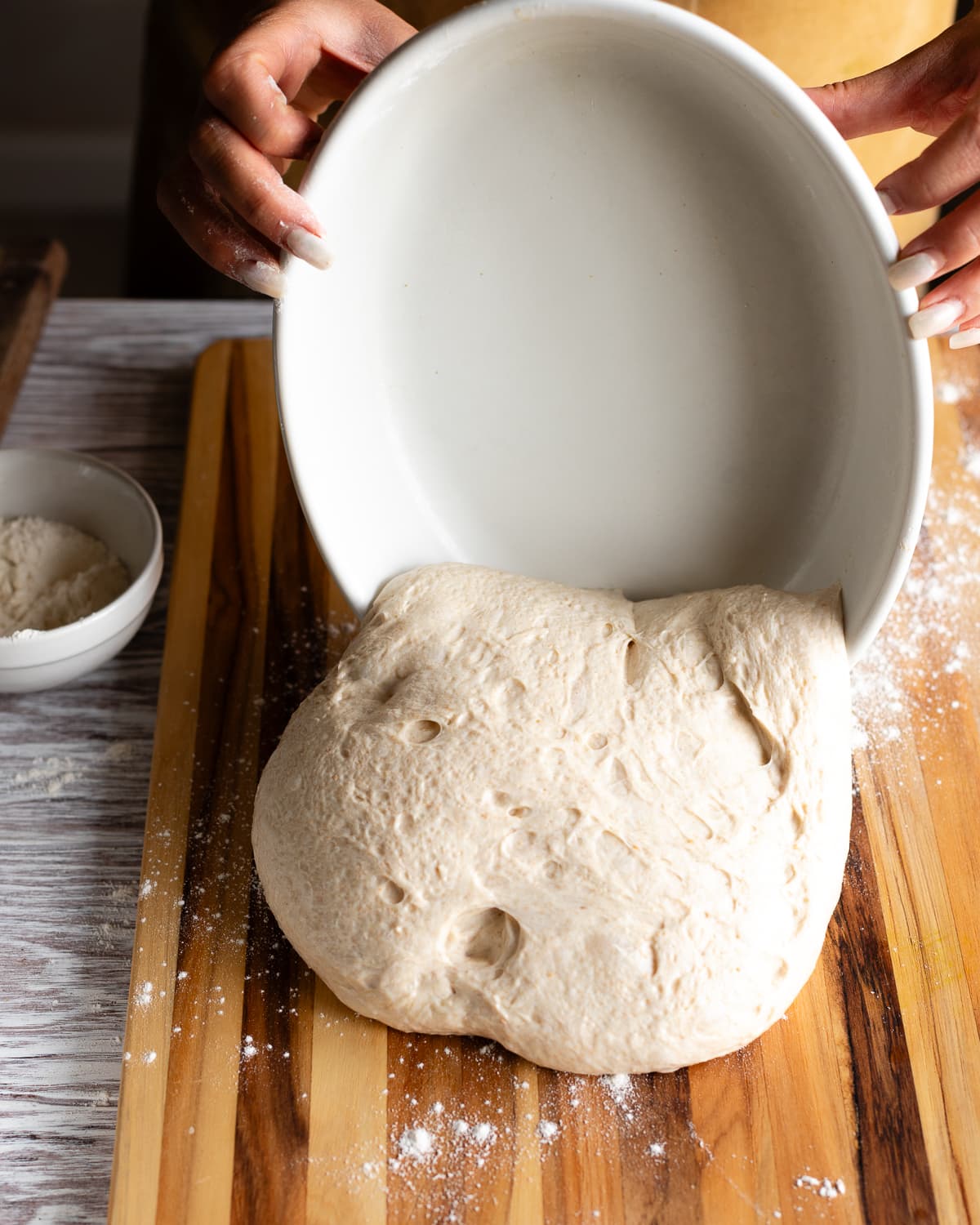
STEP 1. Turn the dough out on a lightly floured work surface

STEP 2. Form a rectangle and fold the top left corner towards the center
Tip
When your dough is fully proofed and ready to shape it should slide out of your proofing vessel very easily.
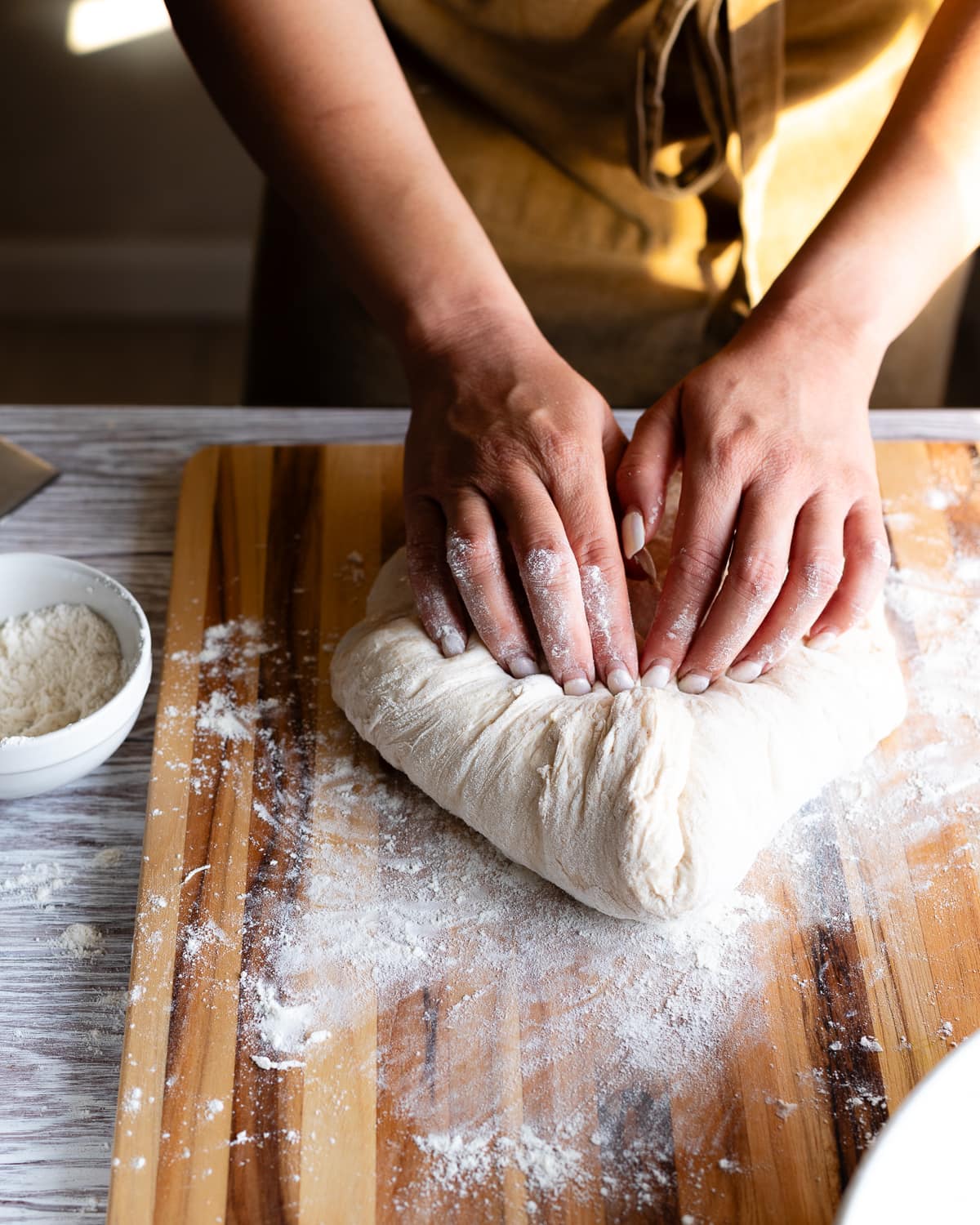
STEP 3. Fold the right corner to meet the left
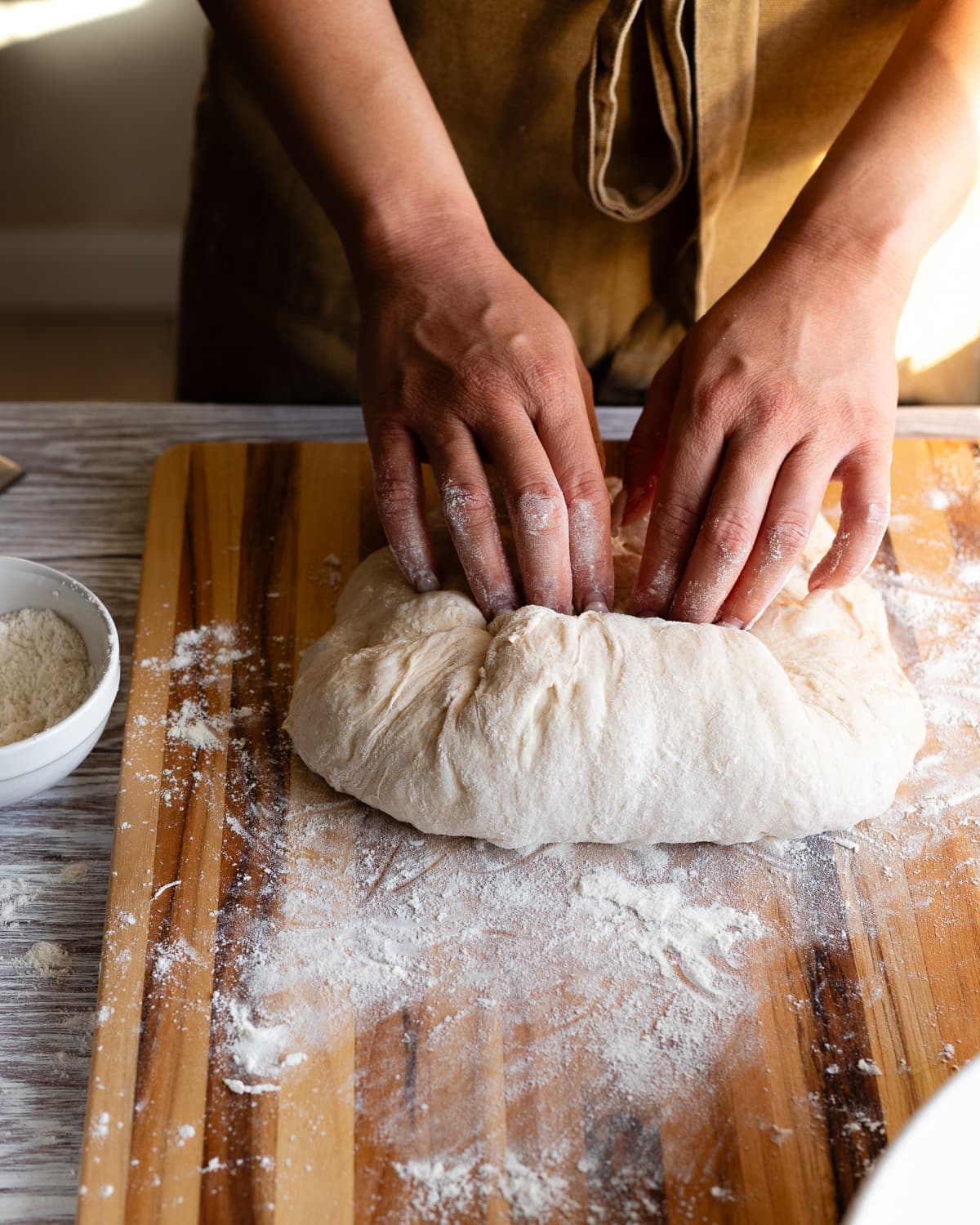
STEP 4. Fold the top down
Tip
Use just enough flour to prevent sticking; excessive flour can compromise the dough's ability to stick to itself and maintain its shape.
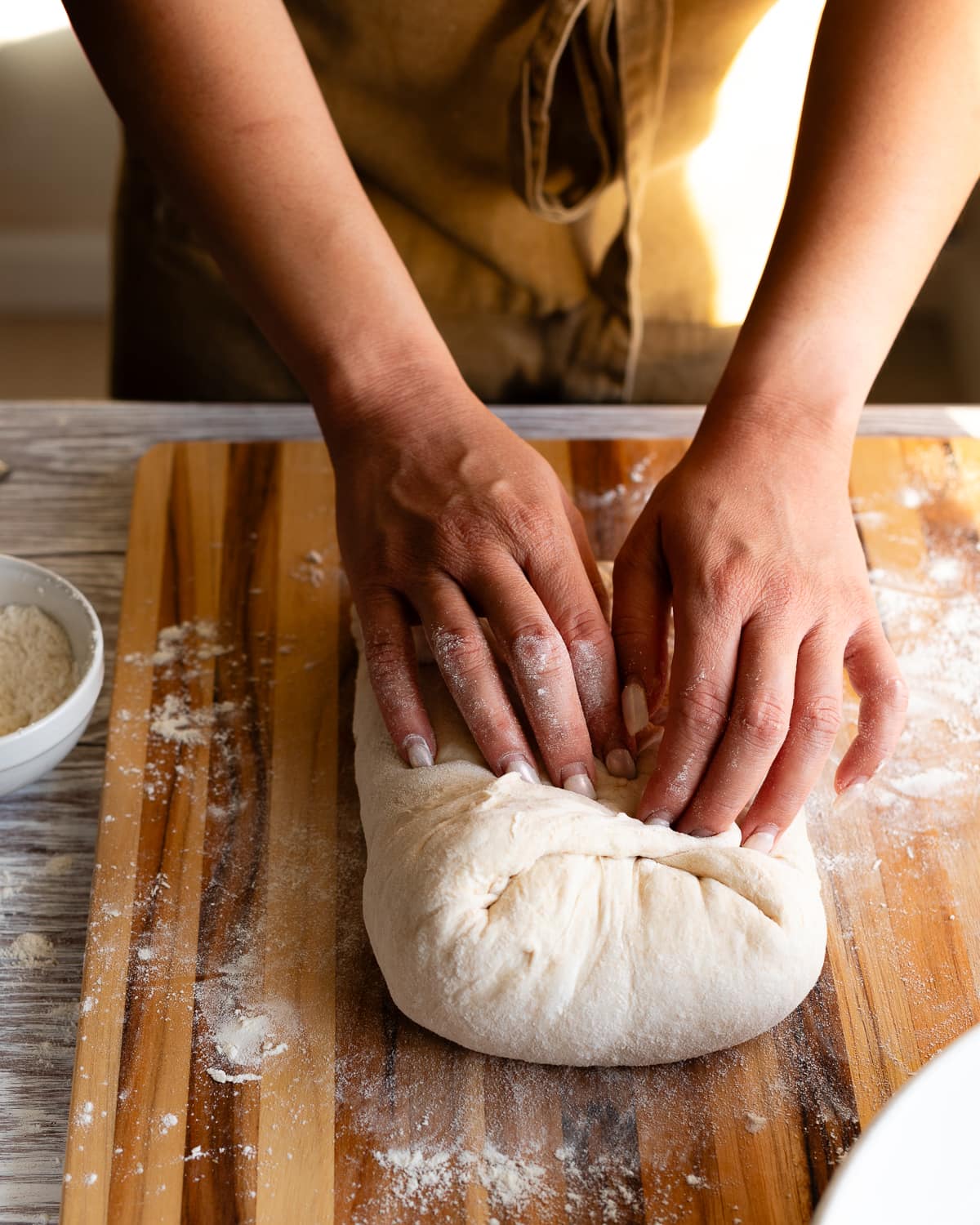
STEP 5. Fold the sides towards the middle
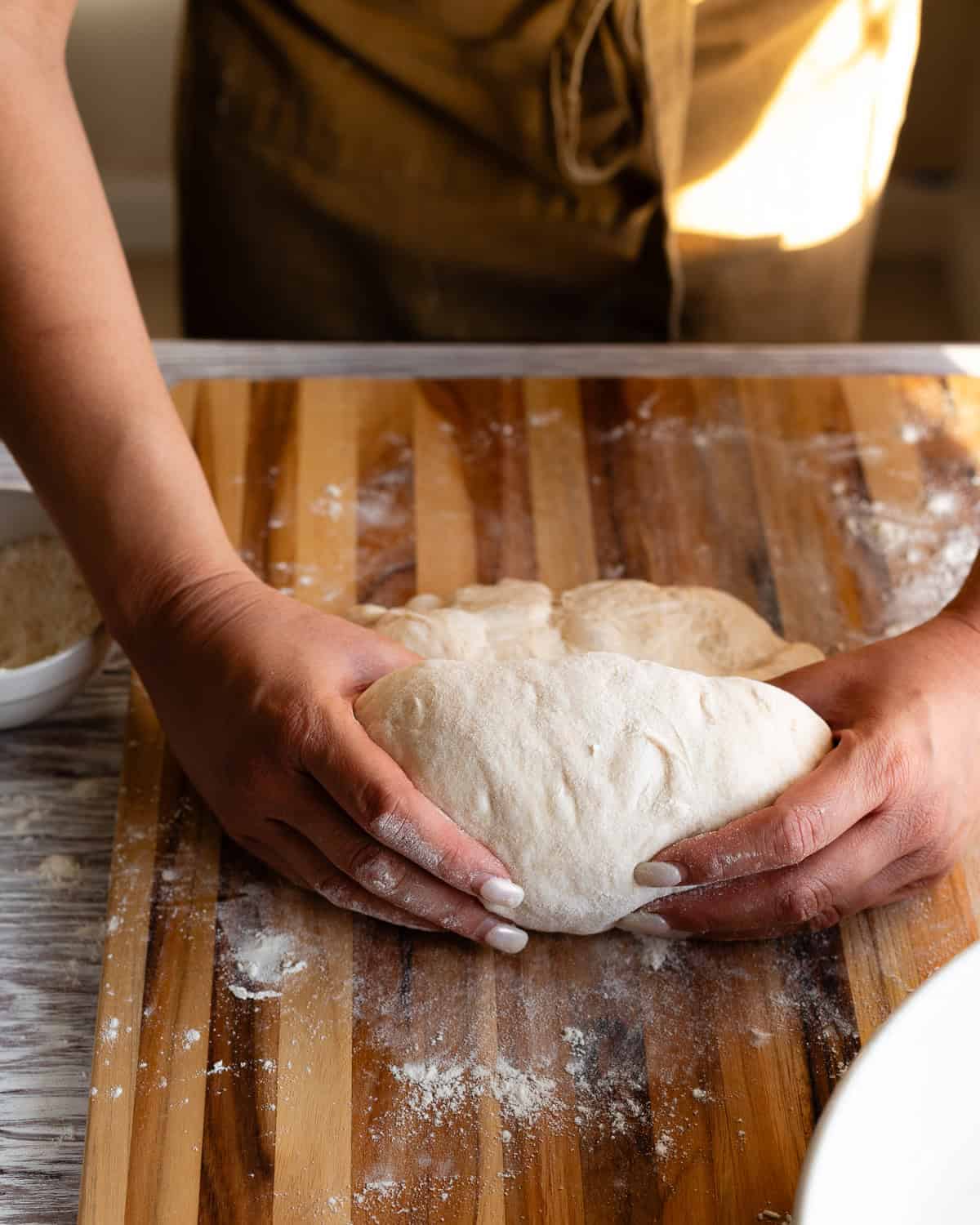
STEP 6. Roll the dough towards yourself
Tip
Handle the dough gently and avoid popping all the bubbles, as this promotes an open and airy crumb structure.
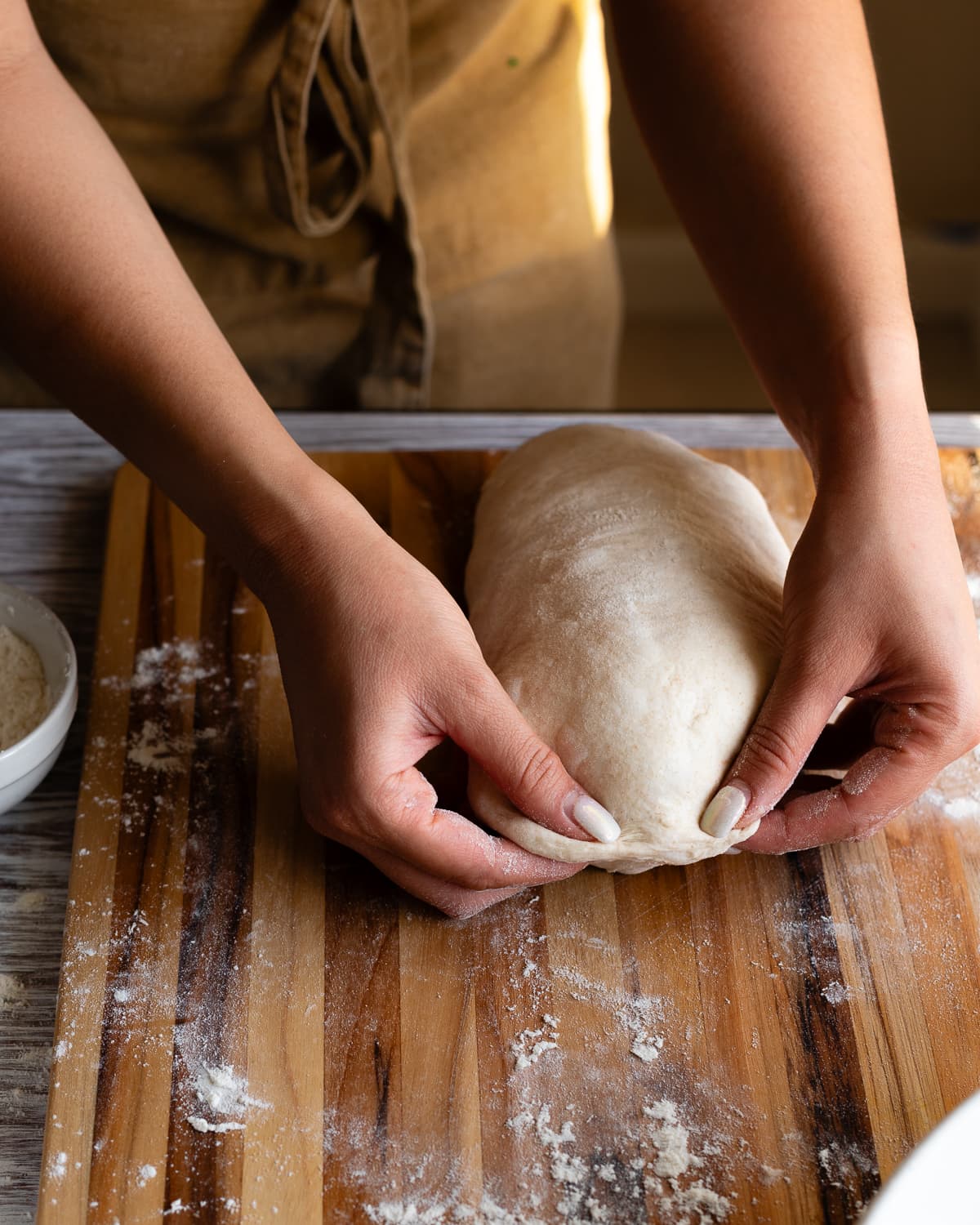
STEP 7. Pinch the ends of the dough
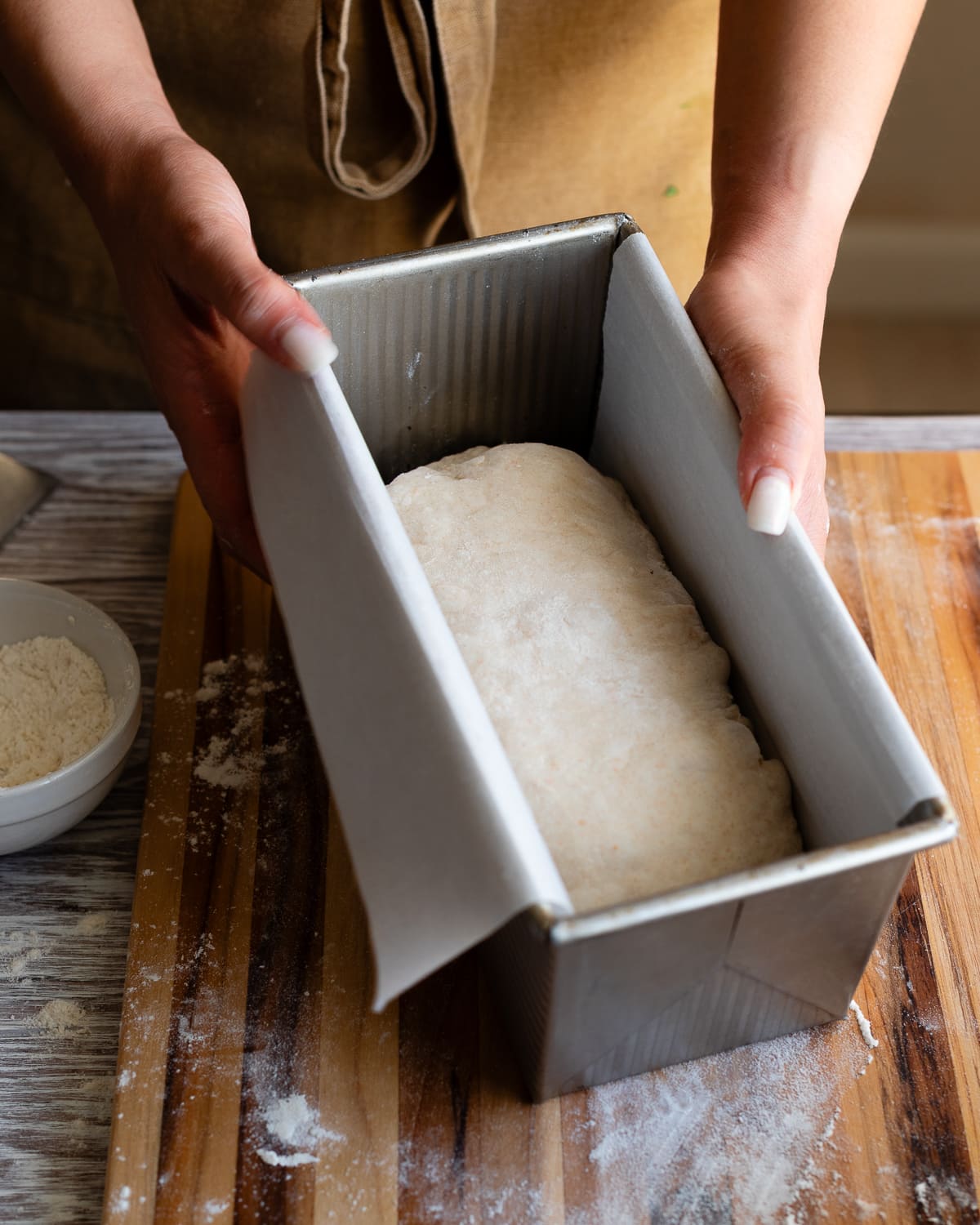
STEP 8. Place the dough into a prepared pan with the seam-side down
How to bake sourdough in a loaf pan
Using a water pan is essential if you want to bake sourdough bread in a loaf pan. Here's how to use one for baking bread:
- Position wire rack in the middle and bottom of the oven. Place pizza stone on the middle rack, if using.
- Preheat oven to 475 F.
- Place a water pan filled with 1-inch of water on the bottom rack.
- Score the surface of the dough.
- Transfer loaf pan to the middle rack (on top of baking stone, if using)
- Add ice cubes to the water pan and quickly close the door.
- Bake the bread dough for 20 minutes.
- Remove the water pan
- Continue baking for another 10 to 15 minutes without the water pan
- Remove your bread from the oven once center of the loaf registers at least 190 F when probed with an instant read thermometer and the crust is golden brown or has reached your desired level of color.
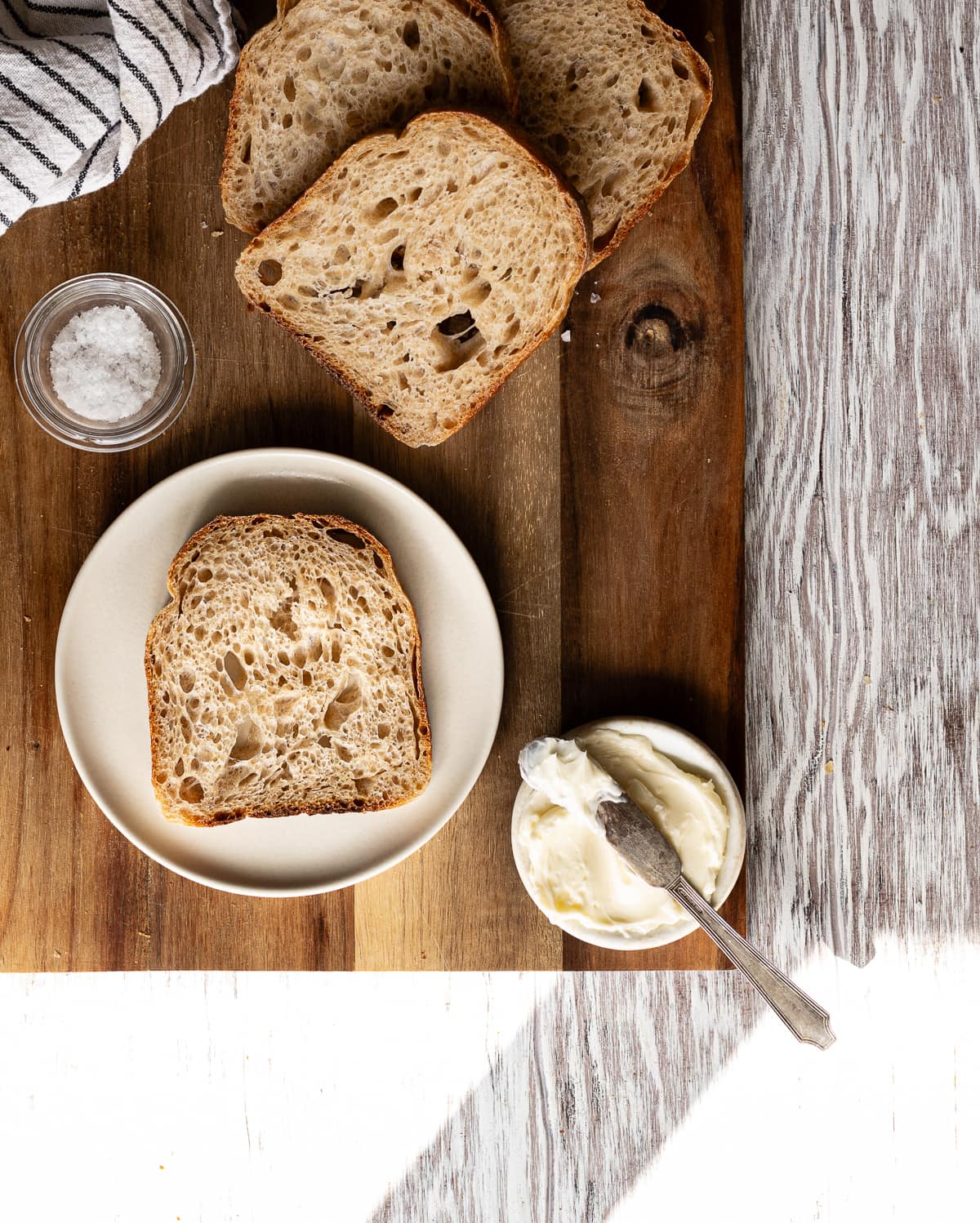
Recipe FAQs
No. You can bake the dough straight out of the refrigerator. Fermentation continues in the refrigerator at a very slow rate, but it’s enough for the bread dough to rise for baking. Cold dough is much easier to score and helps with oven spring.
As dough bakes, heat speeds up fermentation. This causes carbon dioxide production to go on overdrive, and results in a dramatic rise in your bread during the first moments of baking. This is why an extremely hot oven is important for baking bread, a baking stone intensifies the temperature which results in better oven spring.
Yes! Simply shape your loaf into a cylinder shape instead of a boule or batard. Then proof your dough in a loaf pan instead of a banneton and use a water pan during baking.
The high heat required for bread baking is usually too hot for most glass loaf pans. Using one to bake sourdough bread is not ideal and not recommended, as your glass pan could crack and shatter in the oven. The same goes for a terra cotta bread baker. I would recommend using a metal or aluminum pan.
The size of the pan you need depends on the weight of the dough for your recipe! Pullman pans and loaf pans come in all sizes. Around 600 grams of dough will fit in a 9 by 4-inch loaf pan.
Yes! Scoring creates a weak point in your dough, this gives steam a place to escape as your bread bakes. If it isn’t scored, your bread could burst in random places resulting in an uneven loaf.
You may also like
Knead More Help?
Have more questions about this topic? Let me know in the comments!
Pin this post on Pinterest for easy access anytime!
Share your baking triumphs on Instagram - don't forget to tag @makeitdough, I love showcasing your bakes in my stories!
⭐ THANK YOU ⭐
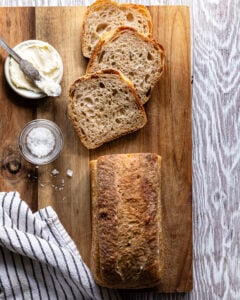
Sourdough Sandwich Loaf Recipe
Equipment
This section may contain affiliate links
Ingredients
Sourdough Starter
- 28 grams sourdough starter mature, unfed
- 56 grams water
- 56 grams all-purpose flour
Dough
- 270 grams bread flour
- 30 grams whole wheat flour
- 200 grams water
- 100 grams sourdough starter active
- 6 grams salt
Click US Customary to view volume measurements
Instructions
- Activate your starter: Mix the unfed starter, water and all-purpose flour in a small container. Let your starter ferment until doubled or tripled in volume (about 4 to 6 hours).28 grams sourdough starter, 56 grams water, 56 grams all-purpose flour
- Mix your dough: In a large mixing bowl, combine water and active sourdough starter. Stir until the starter is almost completely dissolved. Fold the whole wheat flour into the starter mixture. Add all of the bread flour and salt. Stir using a wooden spoon or your hands until no dry traces of flour remain.270 grams bread flour, 30 grams whole wheat flour, 200 grams water, 100 grams sourdough starter, 6 grams salt
- Fold the dough: Complete a set of stretch and folds by picking up one side of the dough and folding it over itself. Repeat until all sides are folded. Transfer the dough to a lightly-oiled bowl, cover with plastic wrap and let the dough rest for 1 hour.
- Strengthen the dough and bulk ferment: As your dough ferments, perform 3 to 4 sets of coil folds inside the bowl at 30 minute intervals, cover your bowl with plastic wrap after you complete each fold. Your dough should appear smooth and pass the windowpane test after the last fold.
- Bench rest: After your last fold, let the dough rest for 1 hour untouched in a warm place. Your dough should look puffy and should increase in volume during this period.
- Shape the dough: Prepare your Pullman pan or loaf pan by greasing it with olive oil or butter, or lining it with a piece of parchment paper.
- Turn your dough out on a lightly-floured work surface. Lightly flatten the dough out into a rectangle (be gentle so you do not pop the air bubbles build up during fermentation).
- Fold the left and right corner of the dough towards the center.
- Fold the tip down towards the center.
- Roll the dough towards yourself into a tight cylinder.
- Pinch the ends of the cylinder. Place the dough into the prepared pan with the seam-side down.
- Cold proof: Cover the pan with plastic wrap. Place your dough inside the refrigerator and proof overnight.
- Prepare for baking: Preheat your oven to 475 F with the wire racks positioned in the middle and bottom. Place pizza stone in the middle (if using). Allow oven to heat up for at least 1 hour.
- 15 minutes prior to baking, place a water pan filled with at least 1-inch of water on the bottom rack of your oven.
- Score: Take the dough out of the refrigerator, uncover and cut a long slash on the top of the dough with a sharp knife or a lame.
- Bake: Bake the dough cold directly from the refrigerator on the middle rack (on top of the baking stone, if using).
- Add ice cubes into your water pan and quickly close the door. Bake for 20 minutes.
- Remove the water pan and bake for an additional 15 to 20 minutes or until the center of the loaf registers at 190 F when probed with an instant read thermometer and the crust reaches your desired color.
- Cool: Transfer the sandwich tin to a cooling rack. Let the dough cool for at least 15 minutes before turning it out of the pan.
- Serve: Allow the loaf to cool for at least 2 hours, before slicing.
- Store: Store any leftover slices in a ziplock bag for up to 5 days at room temperature.
Tips
These recipes were developed and tested using grams for precise measurements. To increase your chances of success, I recommend investing in a kitchen scale. I've included rough volume estimates (in tablespoons and cups), but they might not be totally accurate.
Remember all ovens are unique, these recipes were tested in my oven which runs cooler than others. You might need to lower the temperature if your bake appears to be browning too quickly. Monitor your bake closely and make adjustments if needed.
Notes
Nutrition
I am not a nutritionist or dietitian, any nutrition information provided is an estimate.



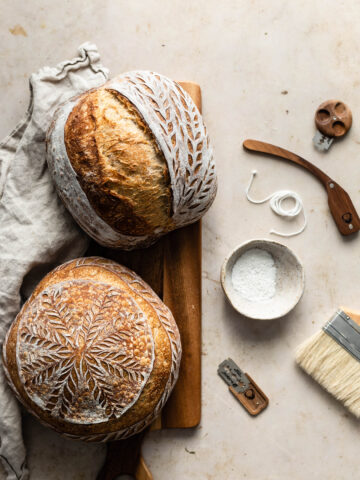
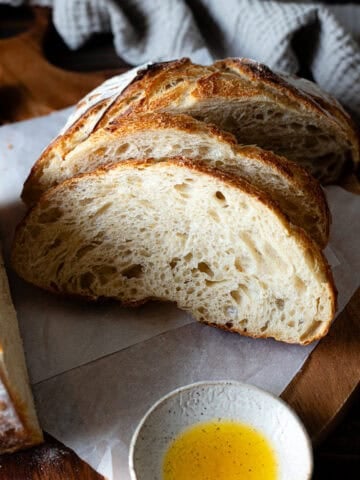
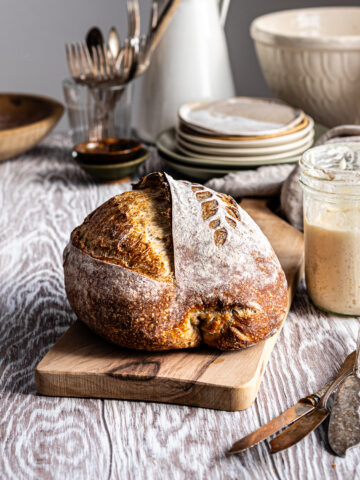
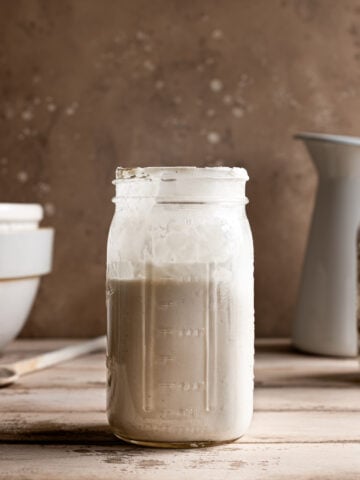
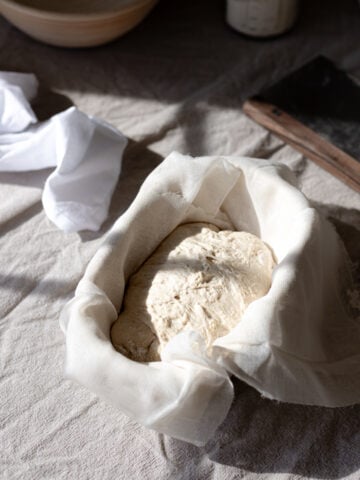
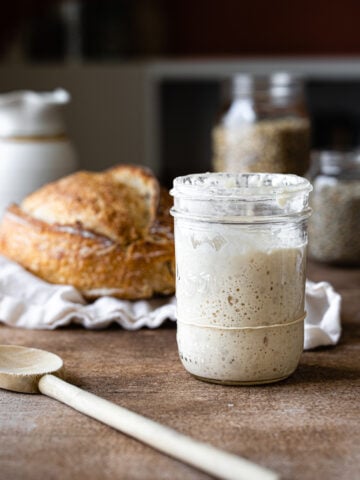
Carolyn says
First, Hello! Your site is very well laid out and informative. My question relates to baking sourdough in open cast iron loaf pans.
I followed the instructions on your site for standard metal loaf pans, but didn't see any specific reference to baking in cast iron loaf pans. Any tips on temperature and timing?
Hannah Dela Cruz says
That’s a great question. I haven’t used a cast iron loaf pan myself, but it should work well as long as it’s well seasoned so the dough doesn’t stick. Just keep an eye on the bake—cast iron retains more heat than lighter metal pans, so your loaf may brown (or scorch) faster.
Ingrid Thomas says
I’ve been using your recipe for over a year. Love your directions that make it easier. My problem is that the starter barely doubles,I have it in a warm spot 75-80 degrees for 6 hours. It barely doubles. Any suggestions? Thank you for your advice.
Hannah Dela Cruz says
Without more specific info about your starter, it's hard to give advice. This post may have some tips that might help - https://makeitdough.com/can-i-bake-with-a-starter-from-the-fridge/
Martine says
The bread tasted delicious. The crust was nice and golden after the first 20 minutes but once I took out the water tray for the last 10 minutes, the top crust burned. Any idea why this would happen?
Hannah Dela Cruz says
Hi Martine! The purpose of removing the water pan is to allow the top crust to crisp up and develop a deeper color. Since every oven is different, yours may simply run hotter than mine so the 10 min baking time may have been too much. Try 5 mins without steam next time and see if that will help.
Jodi says
Hello 🙂
I love this baking method! Curious what, if anything, I’d have to do, to accommodate baking 2 or more loaves at a time?
Could a baking stone be used?
Thank you!
Hannah Dela Cruz says
You can use a baking stone with freeform loaves and using a steam pan.
Liz says
Hi Hannah,
thanks for this loafpan recipe. this us my first time making sourdough bread. Should I do the coil folds after tge 1 hour bench rest or during the bench rest every 30 min which counts to 2 sets.
Warm regards
Liz
Hannah Dela Cruz says
All your folds should be done before the bench rest.
Ingrid Thomas says
Should I cover the pan with the lid provided when I place the bread in the oven for the first 20 minutes?
Hannah Dela Cruz says
Hi Ingrid! This is a great question - if you end up using the cover on your pullman pan, you won't need to add additional steam in the form of the water pan. This is because the cover will trap the steam in in your pan as your dough bakes. Remove the cover after 20 minutes and bake until browned. The cover will prevent your loaf from rising slightly and your crumb will be tighter.
Daisy says
Hi thanks for the recipe!
I was wondering if it is absolutely necessary to ferment/rise in the fridge overnight? I was hoping to make this bread today as I will be out all weekend. Can I let the loaf rise and bake it in the same day?
Hannah Dela Cruz says
Hi Daisy - it's not absolutely necessary, just a great way to break up the baking process so you're not waiting for dough to rise for the whole entire day. I would say you can bake the same day - but make sure you allow for 2 to 4 hours for your final proof, the dough should have noticeably increased in volume before baking, if you know how to use the poke test do that before putting it in the oven.
Sandi MacIver says
Awesome article. Your photos are amazing, if you don't mind me asking, what lens do you use?
Hannah Dela Cruz says
Thanks Sandi! I use a 50mm and a macro lens for all my photos.
I've linked the specific ones in my Amazon store front (affiliate), with all of the photography gear I use.
https://amzn.to/3zysagd
Mike says
Hey, I have a Pullman pan with a lid. Was thinking I could just put the bread in the oven with lid on to capture the steam from the loaf to allow expansion leave it on for 5 to 10 minutes, then pull it off. What do you think?
Hannah Dela Cruz says
I'd leave it on for at least 15 minutes.
Sonny says
Hi!
So I made this recipe and I thought it was going well until I cut into the loaf. It was dense, and didn’t rise. I feel like it was a problem with my starter?
Hannah Dela Cruz says
That may be the case.
Rox says
Is the oven temperature with or without the fan on?
many recipes say to lower the oven temperature after the first 10 or 20 min,
Am I supposed to keep the same high temperature during the whole baking?
Hannah Dela Cruz says
No fan. This particular recipe doesn't call for turning down the temperature.
Tracey says
I did everything as instructed after 20 minutes of 475 the top of my bread was extremely dark so I turned the oven down to 425 for the last 15 minutes to prevent any more browning. when I took the bread out of the oven thethermometer red 220°. Next time I will start out at 450° and bump the temp down to 410 the last 15 minutes.
Hannah Dela Cruz says
Hi Tracey! Those are great adjustments. My oven runs a little colder than most so my oven settings tend to be higher. All ovens have their own little quirks unfortunately.
Jim says
Do you recommend autolyse with this recipe, or is it not needed?
I've only baked a few different sourdough recipes and notice that some include autolyse and others don't, but I'm not sure why....
Hannah Dela Cruz says
Hi Jon - autolyse is just an extra step that you can add to your baking process. It jumpstarts gluten development and helps you create strength without extra effort. Because of the flours used in this recipe, you can add it to this recipe if you want. It won't harm your results.
For more on the topic, check out my dedicated blog on autolyse: https://makeitdough.com/what-is-autolyse/
Julie says
I am using this recipe for the first time as it uses a loaf pan and am new at this! What is the purpose of using a baking stone and a loaf pan at the same time? TYIA!
Hannah Dela Cruz says
Hi Julie! This is a great question! A baking stone retains a lot of heat and mimics the conditions of the superheated floor of a commercial bread oven. The intense burst of heat causes a rapid rise in your dough, this helps ensure your bread will end up taller with an airier crumb.
Julie says
Thank you! I will try this week. I'll place my pan on the stone and see how that works. I have a gas oven which I've been told is not as good for baking, so hope I am able to master it. The recipe is delicious. Still working on getting a good rise!
Hannah Dela Cruz says
Proofing is the trickiest part!
Sue says
This bread recipe is perfect I've been making this sandwich loaf for weeks now I call it a no fuss bread turns out beautifully every time just pop it in the fridge and bake it when I want it. I started this sourdough journey about 3 months ago and found it really hard but I stuck with it then found your recipe wasn't intimidating at all would like to say thankyou.
Hannah Dela Cruz says
You are so welcome! Glad you love the recipe and that you found it approachable.
Ingrid Thomas says
Can the starter be made the night before the dough preparation?
Hannah Dela Cruz says
Absolutely, this is actually how I prefer to do this to save time in the morning. Do a 1:5:5 or 1:10:10 feeding ratio depending on the strength of your starter.